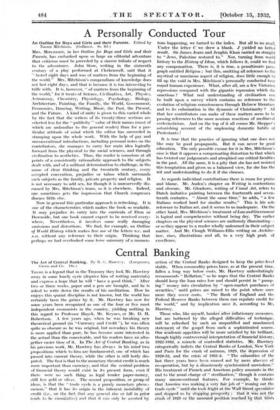A Personally Conducted Tour
An Outline for Boys and Girls and their Parents. Edited by Naomi Mitchison. (Gollancz. 8s. 6d.)
MRS. MITCHISON, in her Outline for Boys and Girls and their Parents, has embarked upon so large an editorial adventure
that criticism must be preceded by a sincere tribute of respect to the adventurer. John Stow, writing in the sixteenth century of a play performed at Clerkenwell, said that it • lasted eight days and was of matters from the beginning of the world." Mrs. Mitchison's compendium of knowledge does not last eight days, and that is because it is too interesting to trifle with. It is, however, " of matters from the beginning of the world," for it treats of Science, Civilization, Art, Physics, Astronomy, Chemistry, Physiology, Psychology, Biology, Architecture, Painting, the Family, the World, Government, Economics, Dancing, Writing, Music, the Past, the Present, and the Future. A kind of unity is given to this varied whole by the fact that the writers of its twenty-three sections are selected less for the "publicity " value of their names (most of which arc unfamiliar to the general reader) than for a par, ticular attitude of mind which the editor has succeeded in stamping upon the whole work. With the help of gay and unconventional introductions, including personal notes on the contributors, she manages to carry her main idea logically forward from the physical to the social sciences, and through civilization to aesthetics. Thus, the reader is conscious at all points of a consistently rationalistic approach to the subjects dealt with, and of a militant determination to challenge, in the name of clear thinking and the twentieth century, every accepted convention, prejudice or taboo which surrounds such subjects as the family, private property and religion. It is not necessary to add sex, for though it is unreservedly dis- cussed by Mrs. Mitchison's team, so it is elsewhere. Indeed, one ,sometitnes gets the impression that Church congresses discuss little else.
Now in general this particular approach is-refreshing. It is one of the characteristics which makes the book so readable. It may prejudice its entry into the curricula of Eton or Downside, but one book cannot expect to be received every- where. Nevertheless, it involves some really damaging omissions and distortions. We find, for example, an Outline of World History which makes free use of the letters B.C. and A.D. without any reference to their origin. Thinking that perhaps we had overlooked some terse summary of a momen- thus happening, we turned to the index. But all to no avail, Under the letter C we dreiv a blank. J yielded no better result. Sir James Jeans and Jenghis Khan carried us straight to " Jews, Palestine restored to." Nor, turning from world history to the History of Ideas, which follows it, could we find any compensation. There is, it is true, a penultimate para- graph entitled Religion ; but this, omitting all reference to the mystical or numinous aspect of religion, does little enough to fill up the void in Mrs. Mitchison's personally conducted tour round human experience. What, after all, are a few Victorian repressions compared with the gigantic repression which she sanctions ? What real understanding of civilization can be built upon a. survey which contains no reference to the evolution of religious consciousness through Hebrew literature and to its culmination in the dynamic of Christianity ? All that her contributors can make of these matters seem to be passing referenceS to the more noxious reactions of mediaeval ecclesiasticism. And on the top of it all comes Mr. Skepper's astonishing account of the unpleasing domestic habits of Protestants !
It is true that the practice of ignoring what one does not like may be good propaganda. But it can never be good education. The only possible excuse for it in Mrs. Mitchison's case is that it opposes a compensating distortion to that which has twisted our judgements and atrophied our critical faculties in the past. All the same, it is a pity that she has not resisted this temptation and given us a balanced view, for she has the wit and understanding to do it if she chooses.
As regards individual contributions there is room for praise and blame. Mr. Auden's chapter on Writing is contentious and obscure. Mr. Gleadowe, writing of Visual Art, refers to Dutch imitative painting between the fourteenth and seven- teenth centuries. " About the same. tithe," he adds, " a few Italians worked hard for similar results." This is WS sole reference to Italian art, and it seems to us inadequate: On the other hand, Mrs. Mitchison's treatment of Law and Government is logical and comprehensive without being dry. The earlier chapters on the physical sciences are uniformly illuminating— or so they appear to a reader wholly unlearned in their subject matter. And Mr. Clough Williams-Ellis writing on Architec- ture, rises, illustrations and all, to a very high peak of excellence.


























































 Previous page
Previous page